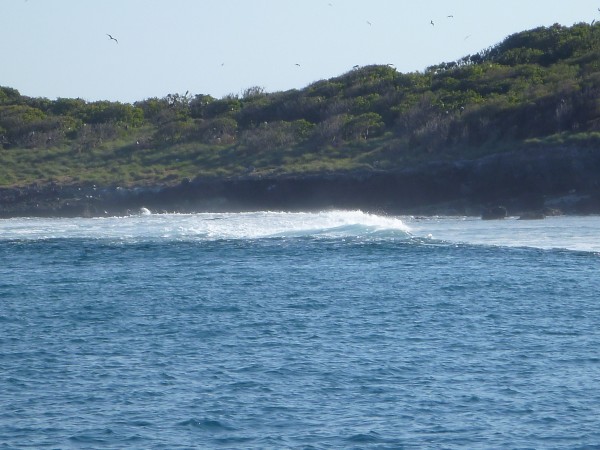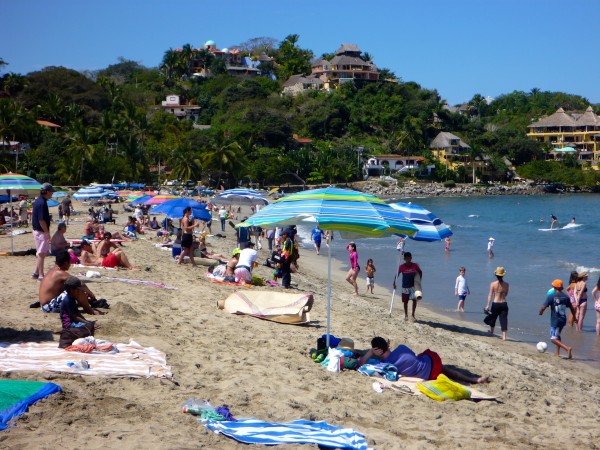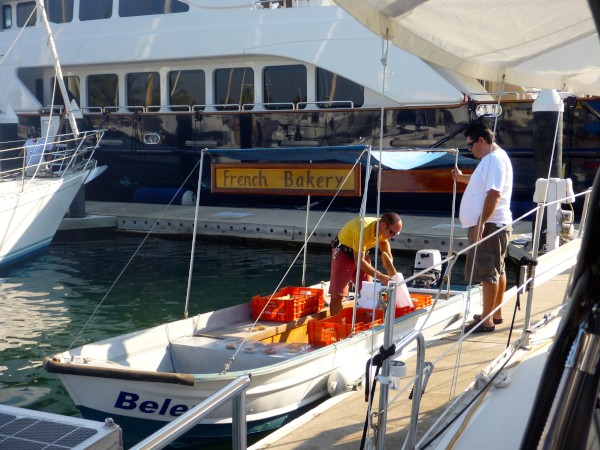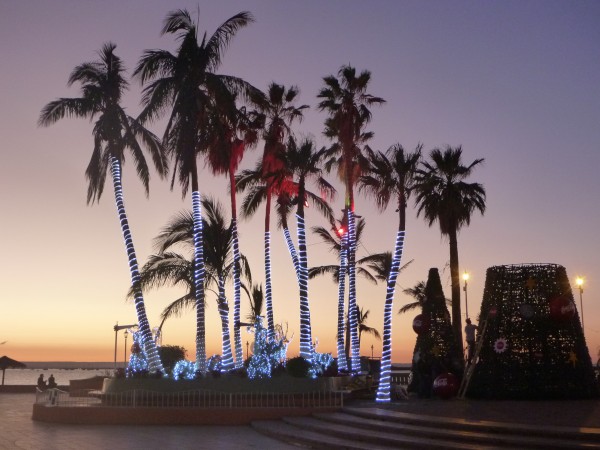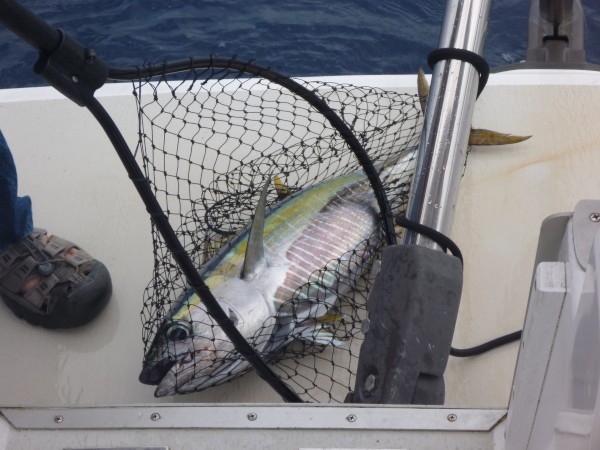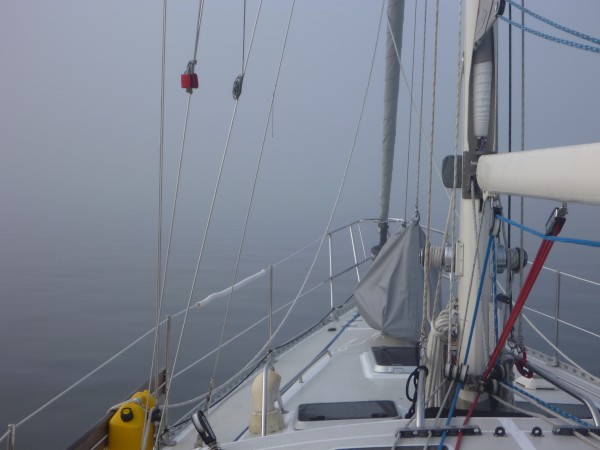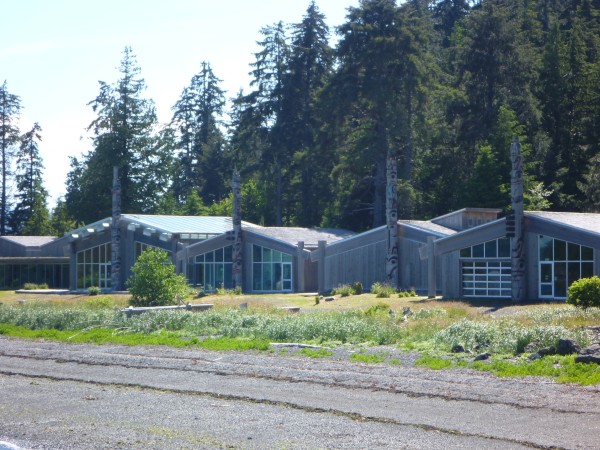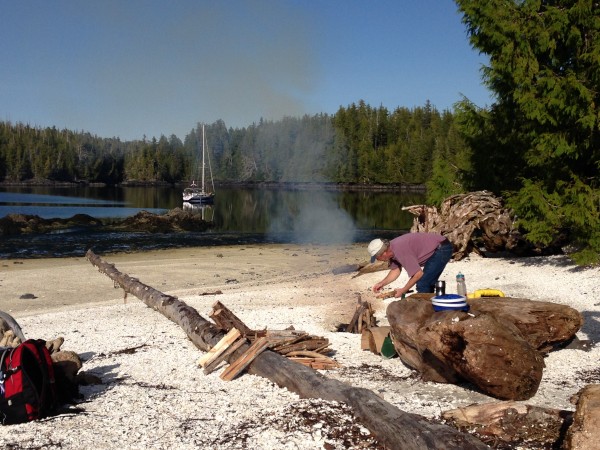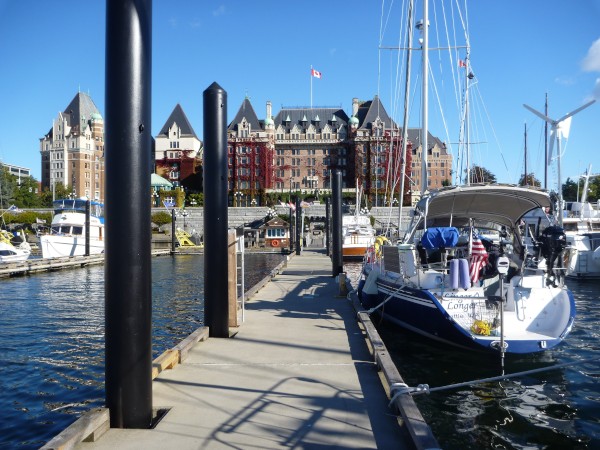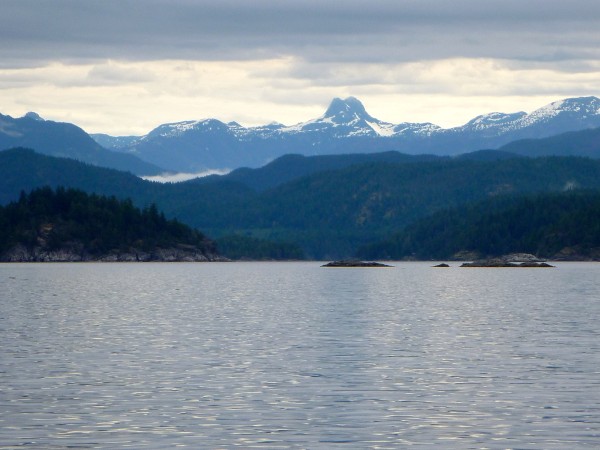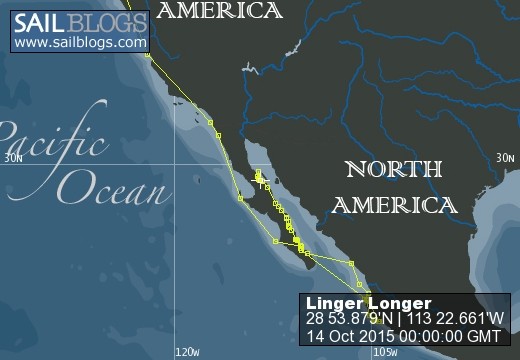
Linger Longer
14 September 2016
06 August 2016
09 July 2016
19 March 2016
19 December 2015
18 December 2015
18 December 2015
03 November 2015
18 July 2015
24 May 2015
04 April 2015
31 March 2015
26 February 2015
15 February 2015 | Barra de Navidad
07 February 2015 | Tenacatita Bay
04 February 2015
26 January 2015 | 19 18.051'N
04 January 2015 | La Cruz, Nayarit, Mexico
25 December 2014 | La Paz, Baja California Sur, Mexico
01 December 2014 | Ensenada, Mexico
Reflections by Kirk
04 January 2015 | La Cruz, Nayarit, Mexico
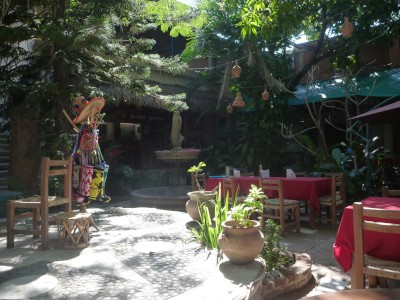
(Photo - restaurant in La Cruz)
Here it is just past the end of a very eventful year for us. We are currently in La Cruz de Huanacaxtle in Bahia de Banderas, a large bay on mainland Mexico's west coast. Banderas Bay would probably be best known for the largest city in the Bay, Puerto Vallarta. The bay is quite large, something like 20 miles north to south and 20 miles west to east so there are a number of cities on its shores. La Cruz tends to be a magnet for cruisers, like us, as the location offers very nice protection from winds and ocean swell that generally come from the northwest. There is a very nice marina here and a large anchorage with many boats at anchor. This is really about the only part of the Bay that affords a safe anchorage in most weather conditions likely to be encountered. There are several marinas in other parts of the bay that afford protection regardless of the weather. There is a big difference between being in a marina and being at anchor.
We have now been in Mexico for a little over a month. Not enough time to feel really comfortable, but long enough to know that it will be very easy to like being here. There are actually only a few, but significant things to accomplish before we really get comfortable. The first is developing a much greater command of the language. We have found that, as a rule, the Mexican population speaks English much better than we speak Spanish. It is quite amazing how the game of charades has helped us with useful sign language. Most of the time our limited Spanish, local's knowledge of English, and sign language can get us by, but not always. I purchased a cell phone down here and am having a heck of a time figuring out how to use it to best advantage as all of the verbal and written messages that it gives me are in Spanish and beyond my current ability to understand. Large supermarkets and places that cater to tourists will frequently have people who speak English. Vendors in the smaller markets, bus drivers, and the average person in the street will smile and shake their heads when we plaintively ask "Habla Ingles?" (Do you speak English?) Trying to discern the contents of many canned food goods depends on how descriptive the pictures on the cans are. For many things, taxi rides, beach venders and open-air market venders, price haggling is the expected way to do business. The idea is to have a friendly conversation while arriving at a fair price for both buyer and seller. Having a better understanding of the language will make for a richer experience and we would recommend that anyone else coming this way for a while take classes beforehand. If you would be coming to stay in a resort, no problems as there will be many who speak English.
Another thing that will enrich our experience is to gain a better understanding of local food products, how to shop for, and how to prepare them. Mexican food and cooking is much different than what we Americans have been taught by establishments such as Taco Bell and local "Mexican" restaurants. You seldom see the words taco or burrito or enchilada on menus or street vendor carts. Increasing our language skills will help to know what the heck we are buying and to seek the advice of locals as to different methods of preserving and preparing. I think it is possible to eat very healthy food at a very low price as soon as we understand things a little better. Buying foodstuff and eating like Mexicans will further enrich our experience. Trying to eat and drink like an American in Mexico is relatively costly and takes an undue amount of effort to find "American " items. You need to go to the supermercados, not quite a Costco but similar in that there are groceries and other general merchandise in a very large store. These are usually located on the outskirts of towns and require a bus ride there and back. There are some food items that we do not understand yet and some unfamiliar things that we have successfully purchased and prepared. We do not tend to be huge red meat eaters and that is good news, at least for us. The whole meat thing will take a little more effort to figure out. In the larger market stores there is packaged meat though all of the labeling is in Spanish. In the parts of towns where locals shop and everything is less expensive, meat is sold at butcher shops (carnicerias). Here you will find large slabs of meat and tell the butcher what you want to have cut. We have not tried this yet, but I'm sure that we will get a red meat craving at some point in time and take the plunge for something to put on the barbecue. We have purchased chicken.
Seafood is plentiful and inexpensive, at least compared to Seattle prices. We have also had some success in catching fish, which is really inexpensive and cannot be beat for freshness. Fish markets (pescaderias) are abundant usually with a wide variety of species, again with only the Spanish names on signs or labels. Only Mexicans are allowed to harvest shellfish, so shrimp, clams, oysters and lobster must be purchased or traded. The trading does not happen at the pescaderias, but from fishing pangas (small open boats) that will come by in anchorages. If you see a panga circling around the anchorage just stand out on the deck and they will come by. Apparently, they really are not allowed to sell us seafood (must be a union thing), but circumvent this by trading for beverages, children's clothing, fishhooks and such. Ceviche is a delightful seafood dish for this climate. You take fresh fish, squeeze a bunch of lime juice over it and let sit for a few hours. The acid from the limes cooks the fish and then you add some chopped veggies, a little cilantro and serve. It is very nice not to have to use the stove which adds more heat to the already very warm boat interior.
Bakeries (panaderias), fruit and vegetable stands (fruterias), pastry shops (reposterias), tortilla factories (tortillerias), carnicerias, pescaderias all tend to be stand-alone shops, but there is often a market where all of these individual venders are located under one roof. The structures may or may not have walls, will have concrete floors and very uneven lighting. These places will be crowded with local people, English is seldom spoken, and price haggling is standard procedure. So we still have a lot to learn to help make living here a more rewarding and fulfilling experience.
We also have to learn to deal with the heat. Living in the northwest corner of the US for so long has not left our bodies in condition to adapt well to the heat. People tell us that our bodies will learn to deal with it better; but so far, that just appears to be an act of faith. I now better understand the concept of the siesta, an afternoon quiet time. It does not necessarily involve a nap, but just trying to hang out quietly in the coolest place you can find until the sun drops low enough or below the horizon and things begin to cool somewhat. Traditional Mexican life revolves around the heat. You wake up and have a morning meal then do your stuff. As the day begins to heat up in the early afternoon, the largest meal of the day is served, then comes siesta time. As things begin to cool maybe a light meal is eaten and you maybe do some more work. Around nine or ten in the evening the social aspect of life starts to happen. That is when there will once again be life on the street, music drifts from restaurant/bars, where long tables full of local people will be eating, chatting and drinking a favorite beverage. Tables will drift into the street where families and friends gather and the delightful sounds of happy children can be heard. This is totally different timing from what we are accustomed to. We have gone into restaurants around six or seven o'clock and found them deserted. By the time we are done, the first of the real evening's crowd may begin to drift in.
We do not know how long we will be in Mexico, but it is obvious to us that the standard six-month tourist visa will not be nearly enough to begin to understand what living here is all about. It is quite easy to understand why so many of the Americans, British, Germans, and other foreign people we have met have been living here, at least in the winter months, for many years. They have learned and the living is good.
We have only been in three populated areas so far, Ensenada, La Paz, and La Cruz. We did not care so much for Ensenada. There was a huge cruise ship presence. During the day, the town was jammed with cruise ship passengers who seemed to care about two things only - buying cheap tourist junk and drinking themselves silly. At night the crowds went away and we did not feel comfortable walking the streets. It was our first stop in Mexico and maybe our discomfort was that we did not understand how things worked down here, but nonetheless we were anxious to leave.
The next stop was in La Paz with a very brief stop in Cabo san Lucas. Cabo also has a large cruise ship factor. The air around the central part of town was also filled with people having a lot of drink-fueled fun, with lots of loud thumping music. We did not give it any kind of a fair chance, and were also anxious to leave as soon as possible. Upon reaching La Paz, the comfort factor went right to the top. Cruise ships seldom visit and the airport is the same one that serves Cabo where the bulk of tourists go. So this was our first chance to get the feel and flavor of a "real" Mexican town. There is a relatively large and well-established "cruiser" community so we had English speaking folks around to help us with directions and where to go for this and that. A very long malecon (wide waterfront walkway) complete with many bronze statues makes for a pleasant walk. Across the street from the malecon, open-air restaurants await to quench our hunger or thirst. It is refreshing to see the large number of families with children out for a walk. It seems that everything you may want or need is available somewhere in town, although some boat parts may not be immediately available. This is where the large established cruiser community becomes helpful. There is a wealth of experience in how to make locally available things work, who would be the best to fabricate replacement parts, or to give advice on the fastest, least expensive ways to ship things to La Paz. Some Americans, even some formerly from Shilshole Marina in Seattle, have set up shop in La Paz and know the ropes. Food shopping from large supermercados to regular grocery stores with cold cases to the open air markets with vender stalls to very small shops that might sell some cold beverages and snack food are all available. Not all are within walking distance, but the marinas tend to have shuttles, there is an extensive and inexpensive bus system and taxis are easy to find and are reasonably priced. We had no need, but were told that excellent medical care is available. Extreme emergencies, such as suffered by a former Shilshole resident, may require a medical evacuation to the States. By the way we talked to John several times and his mental and physical countenance would give no hints to the misfortune he suffered; a very impressive individual.
This is where we decided that our language skills needed help. Our trip to the "open air" market was a bit frustrating. We new nothing about how things worked or how to ask for help. At the fruit and vegetable stand you are supposed to pick up a basket, load it with what you want and then hand the whole thing up to someone at the counter who will tell you the cost. We did not know about the basket thing and a very nice young lady told us what to do using only gestures. OK, got that figured out. Some of the produce was obvious, potato, corn on the cob, string beans, apples, oranges, etc., but there were no prices. Much of the produce was a mystery to us. What is it and how do you prepare it? This part actually turned out to be fun for me. It is amazing what one can learn by using hand gestures prodded along with a big helping of smiles. We bought a few previously unknown to us items of produce with some clue as to what to do with them. I know that we were also given names for these things, but that part failed to sink in. Then comes the paying part. Still unfamiliar with the currency and language of numbers over twenty, it took awhile to figure out what we owed. Forget the whole haggling thing, we were so flustered by then that they took what money was required from my hand and we left. We had a few more learning experiences while in La Paz.
The town just has a very nice feel to it. The weather is fine, warm with a reliable afternoon breeze. People, both native and foreign alike, were friendly and helpful. We spent a very different, but nice Christmas there.
The next stop and our current location is La Cruz. We like this place even more than La Paz - a small town, maybe 2,000 people, also with a large and well-established cruiser community. There are also a number of ex-pats and snowbirds. Most of the streets are paved, albeit with cobblestones. A number of the ex-pats have set up restaurant/bar establishments that feature live music. We have only been here one week, but there has been someplace to listen to live music every night. No cover charges or lines waiting to get in. Just walk in grab a table, sit down and have fun, whether you just want to listen or get on the dance floor and boogie. The weather is warmer with more humidity than La Paz and this is where we learned that we will need better ways to deal with the heat. And it's still winter. Spring/summer will be a real test. Thursdays is a kind of farmers market. A big truck loaded with very fresh produce just sets out boxes and crates of delicious looking stuff. The Sunday market is the most interesting that we have ever seen. The breadth of things available to purchase was staggering. Crafts, from native Huichol art to handmade clothing, jewelry, baskets, weavings, Mexican pottery, carved wood, even a guy who hand rolled cigars while you watched. Food to put in a bag and take with you from breads, French pastries, coffee roasters, smoked fish, empenadas, cookies, cakes and way much more. You could also choose from a wide variety of different kinds of foods to eat on the spot prepared in front of your eyes. Live music and more. There must have been over 100 different venders. It was great.
We will be definitely back to La Cruz and to explore the rest of Bandares Bay, but tomorrow morning we will be off to Manzanillo about 150 miles south. Then we will turn around and slowly make our way back up to Mazatlan and then spend spring/summer exploring the Sea of Cortez. So far things just keep getting better.
Kirk
Here it is just past the end of a very eventful year for us. We are currently in La Cruz de Huanacaxtle in Bahia de Banderas, a large bay on mainland Mexico's west coast. Banderas Bay would probably be best known for the largest city in the Bay, Puerto Vallarta. The bay is quite large, something like 20 miles north to south and 20 miles west to east so there are a number of cities on its shores. La Cruz tends to be a magnet for cruisers, like us, as the location offers very nice protection from winds and ocean swell that generally come from the northwest. There is a very nice marina here and a large anchorage with many boats at anchor. This is really about the only part of the Bay that affords a safe anchorage in most weather conditions likely to be encountered. There are several marinas in other parts of the bay that afford protection regardless of the weather. There is a big difference between being in a marina and being at anchor.
We have now been in Mexico for a little over a month. Not enough time to feel really comfortable, but long enough to know that it will be very easy to like being here. There are actually only a few, but significant things to accomplish before we really get comfortable. The first is developing a much greater command of the language. We have found that, as a rule, the Mexican population speaks English much better than we speak Spanish. It is quite amazing how the game of charades has helped us with useful sign language. Most of the time our limited Spanish, local's knowledge of English, and sign language can get us by, but not always. I purchased a cell phone down here and am having a heck of a time figuring out how to use it to best advantage as all of the verbal and written messages that it gives me are in Spanish and beyond my current ability to understand. Large supermarkets and places that cater to tourists will frequently have people who speak English. Vendors in the smaller markets, bus drivers, and the average person in the street will smile and shake their heads when we plaintively ask "Habla Ingles?" (Do you speak English?) Trying to discern the contents of many canned food goods depends on how descriptive the pictures on the cans are. For many things, taxi rides, beach venders and open-air market venders, price haggling is the expected way to do business. The idea is to have a friendly conversation while arriving at a fair price for both buyer and seller. Having a better understanding of the language will make for a richer experience and we would recommend that anyone else coming this way for a while take classes beforehand. If you would be coming to stay in a resort, no problems as there will be many who speak English.
Another thing that will enrich our experience is to gain a better understanding of local food products, how to shop for, and how to prepare them. Mexican food and cooking is much different than what we Americans have been taught by establishments such as Taco Bell and local "Mexican" restaurants. You seldom see the words taco or burrito or enchilada on menus or street vendor carts. Increasing our language skills will help to know what the heck we are buying and to seek the advice of locals as to different methods of preserving and preparing. I think it is possible to eat very healthy food at a very low price as soon as we understand things a little better. Buying foodstuff and eating like Mexicans will further enrich our experience. Trying to eat and drink like an American in Mexico is relatively costly and takes an undue amount of effort to find "American " items. You need to go to the supermercados, not quite a Costco but similar in that there are groceries and other general merchandise in a very large store. These are usually located on the outskirts of towns and require a bus ride there and back. There are some food items that we do not understand yet and some unfamiliar things that we have successfully purchased and prepared. We do not tend to be huge red meat eaters and that is good news, at least for us. The whole meat thing will take a little more effort to figure out. In the larger market stores there is packaged meat though all of the labeling is in Spanish. In the parts of towns where locals shop and everything is less expensive, meat is sold at butcher shops (carnicerias). Here you will find large slabs of meat and tell the butcher what you want to have cut. We have not tried this yet, but I'm sure that we will get a red meat craving at some point in time and take the plunge for something to put on the barbecue. We have purchased chicken.
Seafood is plentiful and inexpensive, at least compared to Seattle prices. We have also had some success in catching fish, which is really inexpensive and cannot be beat for freshness. Fish markets (pescaderias) are abundant usually with a wide variety of species, again with only the Spanish names on signs or labels. Only Mexicans are allowed to harvest shellfish, so shrimp, clams, oysters and lobster must be purchased or traded. The trading does not happen at the pescaderias, but from fishing pangas (small open boats) that will come by in anchorages. If you see a panga circling around the anchorage just stand out on the deck and they will come by. Apparently, they really are not allowed to sell us seafood (must be a union thing), but circumvent this by trading for beverages, children's clothing, fishhooks and such. Ceviche is a delightful seafood dish for this climate. You take fresh fish, squeeze a bunch of lime juice over it and let sit for a few hours. The acid from the limes cooks the fish and then you add some chopped veggies, a little cilantro and serve. It is very nice not to have to use the stove which adds more heat to the already very warm boat interior.
Bakeries (panaderias), fruit and vegetable stands (fruterias), pastry shops (reposterias), tortilla factories (tortillerias), carnicerias, pescaderias all tend to be stand-alone shops, but there is often a market where all of these individual venders are located under one roof. The structures may or may not have walls, will have concrete floors and very uneven lighting. These places will be crowded with local people, English is seldom spoken, and price haggling is standard procedure. So we still have a lot to learn to help make living here a more rewarding and fulfilling experience.
We also have to learn to deal with the heat. Living in the northwest corner of the US for so long has not left our bodies in condition to adapt well to the heat. People tell us that our bodies will learn to deal with it better; but so far, that just appears to be an act of faith. I now better understand the concept of the siesta, an afternoon quiet time. It does not necessarily involve a nap, but just trying to hang out quietly in the coolest place you can find until the sun drops low enough or below the horizon and things begin to cool somewhat. Traditional Mexican life revolves around the heat. You wake up and have a morning meal then do your stuff. As the day begins to heat up in the early afternoon, the largest meal of the day is served, then comes siesta time. As things begin to cool maybe a light meal is eaten and you maybe do some more work. Around nine or ten in the evening the social aspect of life starts to happen. That is when there will once again be life on the street, music drifts from restaurant/bars, where long tables full of local people will be eating, chatting and drinking a favorite beverage. Tables will drift into the street where families and friends gather and the delightful sounds of happy children can be heard. This is totally different timing from what we are accustomed to. We have gone into restaurants around six or seven o'clock and found them deserted. By the time we are done, the first of the real evening's crowd may begin to drift in.
We do not know how long we will be in Mexico, but it is obvious to us that the standard six-month tourist visa will not be nearly enough to begin to understand what living here is all about. It is quite easy to understand why so many of the Americans, British, Germans, and other foreign people we have met have been living here, at least in the winter months, for many years. They have learned and the living is good.
We have only been in three populated areas so far, Ensenada, La Paz, and La Cruz. We did not care so much for Ensenada. There was a huge cruise ship presence. During the day, the town was jammed with cruise ship passengers who seemed to care about two things only - buying cheap tourist junk and drinking themselves silly. At night the crowds went away and we did not feel comfortable walking the streets. It was our first stop in Mexico and maybe our discomfort was that we did not understand how things worked down here, but nonetheless we were anxious to leave.
The next stop was in La Paz with a very brief stop in Cabo san Lucas. Cabo also has a large cruise ship factor. The air around the central part of town was also filled with people having a lot of drink-fueled fun, with lots of loud thumping music. We did not give it any kind of a fair chance, and were also anxious to leave as soon as possible. Upon reaching La Paz, the comfort factor went right to the top. Cruise ships seldom visit and the airport is the same one that serves Cabo where the bulk of tourists go. So this was our first chance to get the feel and flavor of a "real" Mexican town. There is a relatively large and well-established "cruiser" community so we had English speaking folks around to help us with directions and where to go for this and that. A very long malecon (wide waterfront walkway) complete with many bronze statues makes for a pleasant walk. Across the street from the malecon, open-air restaurants await to quench our hunger or thirst. It is refreshing to see the large number of families with children out for a walk. It seems that everything you may want or need is available somewhere in town, although some boat parts may not be immediately available. This is where the large established cruiser community becomes helpful. There is a wealth of experience in how to make locally available things work, who would be the best to fabricate replacement parts, or to give advice on the fastest, least expensive ways to ship things to La Paz. Some Americans, even some formerly from Shilshole Marina in Seattle, have set up shop in La Paz and know the ropes. Food shopping from large supermercados to regular grocery stores with cold cases to the open air markets with vender stalls to very small shops that might sell some cold beverages and snack food are all available. Not all are within walking distance, but the marinas tend to have shuttles, there is an extensive and inexpensive bus system and taxis are easy to find and are reasonably priced. We had no need, but were told that excellent medical care is available. Extreme emergencies, such as suffered by a former Shilshole resident, may require a medical evacuation to the States. By the way we talked to John several times and his mental and physical countenance would give no hints to the misfortune he suffered; a very impressive individual.
This is where we decided that our language skills needed help. Our trip to the "open air" market was a bit frustrating. We new nothing about how things worked or how to ask for help. At the fruit and vegetable stand you are supposed to pick up a basket, load it with what you want and then hand the whole thing up to someone at the counter who will tell you the cost. We did not know about the basket thing and a very nice young lady told us what to do using only gestures. OK, got that figured out. Some of the produce was obvious, potato, corn on the cob, string beans, apples, oranges, etc., but there were no prices. Much of the produce was a mystery to us. What is it and how do you prepare it? This part actually turned out to be fun for me. It is amazing what one can learn by using hand gestures prodded along with a big helping of smiles. We bought a few previously unknown to us items of produce with some clue as to what to do with them. I know that we were also given names for these things, but that part failed to sink in. Then comes the paying part. Still unfamiliar with the currency and language of numbers over twenty, it took awhile to figure out what we owed. Forget the whole haggling thing, we were so flustered by then that they took what money was required from my hand and we left. We had a few more learning experiences while in La Paz.
The town just has a very nice feel to it. The weather is fine, warm with a reliable afternoon breeze. People, both native and foreign alike, were friendly and helpful. We spent a very different, but nice Christmas there.
The next stop and our current location is La Cruz. We like this place even more than La Paz - a small town, maybe 2,000 people, also with a large and well-established cruiser community. There are also a number of ex-pats and snowbirds. Most of the streets are paved, albeit with cobblestones. A number of the ex-pats have set up restaurant/bar establishments that feature live music. We have only been here one week, but there has been someplace to listen to live music every night. No cover charges or lines waiting to get in. Just walk in grab a table, sit down and have fun, whether you just want to listen or get on the dance floor and boogie. The weather is warmer with more humidity than La Paz and this is where we learned that we will need better ways to deal with the heat. And it's still winter. Spring/summer will be a real test. Thursdays is a kind of farmers market. A big truck loaded with very fresh produce just sets out boxes and crates of delicious looking stuff. The Sunday market is the most interesting that we have ever seen. The breadth of things available to purchase was staggering. Crafts, from native Huichol art to handmade clothing, jewelry, baskets, weavings, Mexican pottery, carved wood, even a guy who hand rolled cigars while you watched. Food to put in a bag and take with you from breads, French pastries, coffee roasters, smoked fish, empenadas, cookies, cakes and way much more. You could also choose from a wide variety of different kinds of foods to eat on the spot prepared in front of your eyes. Live music and more. There must have been over 100 different venders. It was great.
We will be definitely back to La Cruz and to explore the rest of Bandares Bay, but tomorrow morning we will be off to Manzanillo about 150 miles south. Then we will turn around and slowly make our way back up to Mazatlan and then spend spring/summer exploring the Sea of Cortez. So far things just keep getting better.
Kirk
Comments
| Vessel Name: | S/V Linger Longer |
| Vessel Make/Model: | Sceptre 41/43 |
| Hailing Port: | Seattle, WA |
| Crew: | Kirk & Kristin Doyle |
| Extra: | |
| Home Page: | http://www.k2doyle.com |
S/V Linger Longer's Photos - Main
|
Heading north into the Sea of Cortez for the summer where there is less change of hurricanes.
72 Photos
Created 19 December 2015
|
Who: Kirk & Kristin Doyle
Port: Seattle, WA
